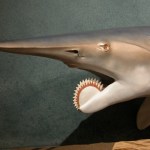National Geographic
Someone just asked on Facebook if humans are naturally carnivores. My response: What is a carnivore? Taxon? A certain percentage of meat in the diet? Some, even if just a few, humans living mostly off meat? What? Then, what is “naturally”? Genetically determined and unavoidable? Required because of our gut, or some nutritional thing? What if we were like cats, genetically driven to be effective hunters but seeming in need of some training from mom. Does that make it not natural? And, finally, of course, define the verb “to be” here. Thank you.
So, with that in mind, what about the sentence…
Teachers- the USASEF Team is thrilled to announce the launch of our video resource library featuring presentations from our 2014 X-STEM Symposium! The 2014 X-STEM Extreme STEM Symposium- presented by Northrop Grumman Foundation and MedImmune- featured interactive presentations and workshops by an exclusive group of visionaries who aimed to empower and inspire elementary through high school students about careers in science, technology, engineering and mathematics (STEM). Now, you can bring these STEM Professionals into your classroom with our FREE library of 15-…
"Art has never been a popularity contest." -James Levine
Sometimes, you might feel like you've heard it all, seen it all, and that nothing's original anymore. But I beg to differ. Just because great things have come before doesn't mean that there aren't great things happening right now. While it might "only" be a cover of a Kanye West song (which itself heavily samples a Ray Charles song, at one time featured here), I encourage you to listen to the Automatic's brilliant version of
Gold Digger.
And while the stories of the Universe I tell you about here don't tend to be my personal, original…
tags: Watch a National Geographic Bird Illustrator at Work, field guides, books, bird art, illustrator, National Geographic, Jonathan Alderfer, streaming video
See harlequin ducks come alive on paper in this time-lapse video featuring National Geographic bird expert and illustrator Jonathan Alderfer.
I've always been a huge vampire fan -- I watched my first Dracula movie when I was about 8-10 years old, on TV, one of the vintage Hammer films with Christopher Lee. I read the original novel when I was a teenager and was a fan of the Marvel comic versions as well. Since then, I've read a zillion vampire novels, read more comics and watched a ton of vampire movies and TV series -- Dark Shadows, Buffy and more. My favourite Dracula will always be Lee though I've also appreciated Lugosi, Louis Jordan and especially Jack Palance. The more romantic versions by Gary Oldman or Frank Langella…
Have you ever said to yourself, "Self, have you ever said to your self, 'What are African wild animals up to right now?'"
Now you can satisfy your self's overly demanding curiosity with National Geographic's WildCam. Don't worry, unlike most streaming webcam feeds, this is one you won't have to delete from your browser's history. The WildCam program is designed to inspire more talk about conservation by plopping viewers down right in the middle of the wild. Like, the real wild. Like, the no-messin-around-or-animals-gone-eat-you-up wild.
In an age where people are inundated with edited sound…
The Hawaiian archipelago has a lot of amazing and adorable creatures. Here's a great shot of a baby white tern, or Manu-o-ku, c/o my lab mate Tonatiuh. It was taken by National Geographic explorers in 2005 while they were in the Northwestern Hawaiian Islands.When people think of Hawaii, they think of the 8 main islands where people live, but the archipelago stretches another 1,200 miles and includes many islands and atolls with vibrant coral reefs and amazing wildlife. This area is so special it's practically off limits to everyone but scientists, protected by NOAA's National Marine Sanctuary…
Press release on the partnership with ScienceBlogsTM. Nothing should change around these parts, though I might avail myself of the image library instead of going to Wikipedia all the time. When I was a kid I will admit though that reading issues of National Geographic from 1910 or 1920 was one of my more bizarre pleasures; it was a bit of an anthropological exercise, with the irony being the target was itself anthropology.
tags: ScienceBlogs, National Geographic, news
I have friends at National Geographic, so I was most pleased to read early this morning (last night, USA time), that ScienceBlogs and National Geographic have teamed up to provide outstanding science and nature content to the public!
I am sure it has not been a mystery to any of you that ScienceBlogs and National Geographic share the same ultimate mission: to cultivate widespread interest in science and the natural world. Starting today, SB-NG will work together to advance this common mission by providing new content, applications, and…
Feast your eyes on this, squares...
Big up to Ben Thorne for passing this along. And big up to his business, Sneaky's BBQ, the best ribs and pulled pork in the Bay Area. Check them out at www.sneakysbbq.blogspot.com.
Starting tomorrow, National Geographic embarks upon a week of adventure. It's Nat Geo's Second Annual Expedition Week, seven nights of journeys to places as diverse as Mars and the deep ocean. Every night at 9PM, Nat Geo takes us on a different expedition sure to fascinate and amaze. I was lucky enough to preview this entire series, and I have to say, it's a pretty great week that's full of science as well as adventure. Be sure to tune in for any that pique your interest! Here's the lineup for the week:
The week starts with Sunday's Search For The Amazon Head Shrinkers. The documentary…
National Geographic remains the world's premier showcase of nature photography. But I often wonder for how much longer.
It is easy to maintain a virtual monopoly on high quality imagery when camera equipment and publishing are expensive and require a highly specialized skill set. But neither of these things is true anymore. Professional-quality photo equipment is broadly affordable. And numerous online venues allow anyone with an internet connection to distribute their photos for free.
Consider the following fantastic arthropod photographers, all from the galleries of the free…
tags: nature, mammals, Antarctica, blue whale, Balaenoptera musculus, National Geographic, streaming video
Researchers on a National Geographic expedition seek answer some mysteries surrounding Blue Whales, Balaenoptera musculus, and find tantalizing clues, but big questions remain unanswered.
tags: nature, mammals, Antarctica, blue whale, Balaenoptera musculus, National Geographic, streaming video
Blue whales, Balaenoptera musculus, have complex calls that can be heard for miles. In this National Geographic video, we meet one scientist is on a mission to uncover the meaning of their songs.
For centuries, people have wondered about our existence. Where did we come from? How did we get to where we are today? This kind of self-reflection has founded religions and spurred the greatest achievements in science. But only recently have we had the technology to truly trace backward and unravel the mystery of our origins. We have discovered our ancestors, and found clues as to how and when we branched from the other primates. But what about after that? How did we go from a small group of hominids in East Africa to a globally dominating species?
Enter Kevin Bacon.
No, seriously.
Tomorrow…
While we often think of features like the Grand Canyon as impressive, majestic landscapes, we forget that only 1/3 of this planet of ours is above sea level. The rest is underwater. And while many of us may know what coral reefs or near-shore habiatats look like, we rarely get to see what the seabed looks like on a grander scale. National Geographic, as it turns out, decided that the hidden landscape of the ocean floor needed to be revealed.
Thanks to cutting edge technology and amazing CGI animation, this Sunday, Aug 9th at 9 PM EST, National Geographic Channel is airing its newest…
Swooping from the top of a saguaro down to the desert floor: Howard Bourne swings the crane while Martin Dohrn drives the camera. Tucson Mountain Park.
What was I doing in Arizona last month?
Thanks for asking. I was helping a film crew wrangle harvester ants for an upcoming National Geographic documentary. The crew, an all-star cast of nature cinematographers including Martin Dohrn, Howard Bourne, and Gavin Thurston, is still in the field- you can follow their progress by blog. The program is tentatively titled "Planet of the Ants" and should be on television in 2010.
If…
The fear mongers over at National Geographic are at it again. They have released what they claim to be actual prehistoric photographs of nightmarish creatures. Just think of your most feared animal and combine it with either a cooking utensil or a wood shop tool. That might give you an idea of how National Geographic came up with these things.
The CraftsMan-Eating Shark, known for its ability to sever the limbs of its victims with a straight or beveled cut.
I smell "evolution" and I don't like it.
I came up with one of my own:
check out the rest here.
It's no shock to anyone who reads this blog regularly that I adore the National Geographic Channel. They never seem to run out of awesome features and amazing specials that totally turn my nerd on. I may be a biologist at heart, but when watching Nat Geo, I suddenly become a geologist, paleontologist, physicist, or whatever specialty would be required to be a total nerd for whatever is on. Of course, when it's a biology special, I super nerd out.
So imagine the thoughts that are running through my head when I see the title "Hooked: Monsters of the Deep." Oh yeah, you could hear my nerdiness…
tags: Bat Falcon, Falco rufigularis, South America, nature, National Geographic, streaming video
This female bat falcon, Falco rufigularis, makes dazzling mid-air catches over Mayan ruins in Guatemala to feed her chicks [2:15]



